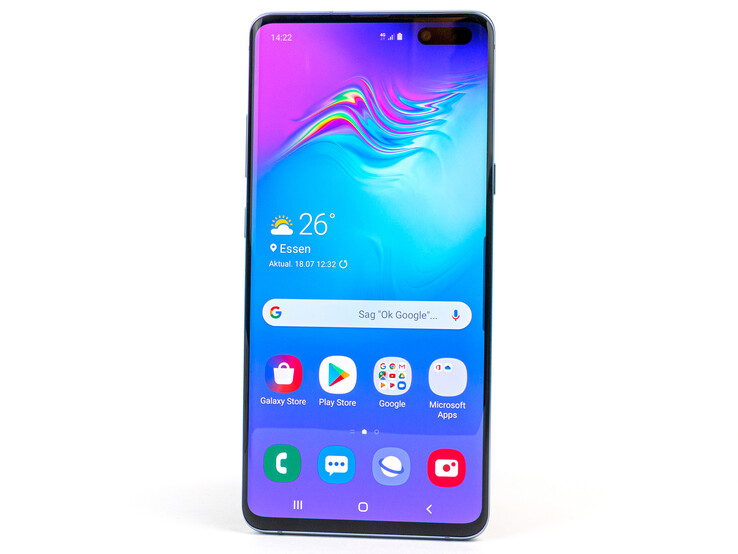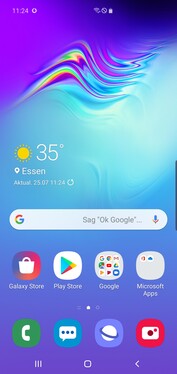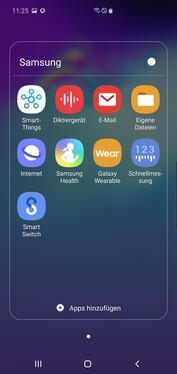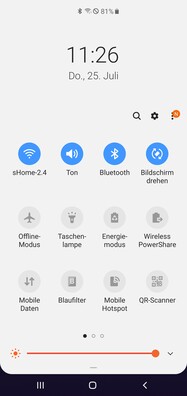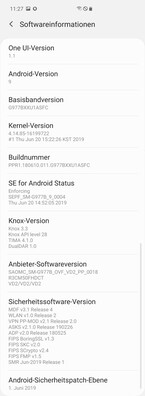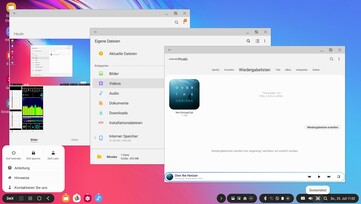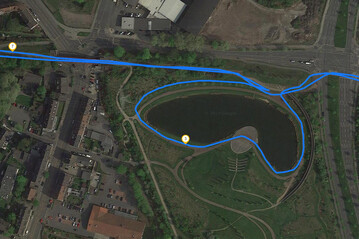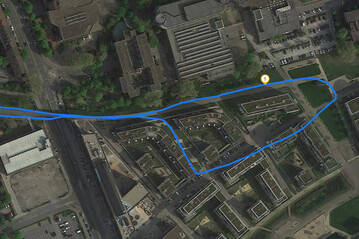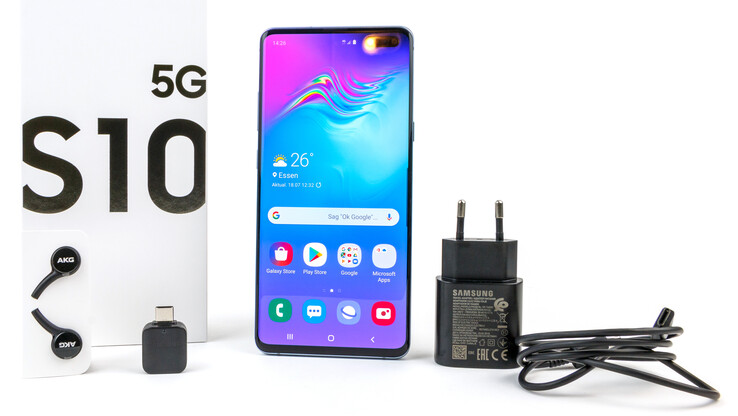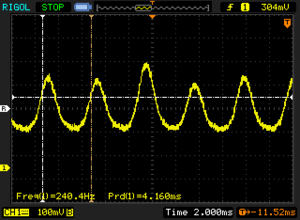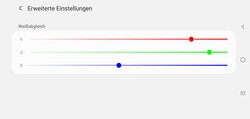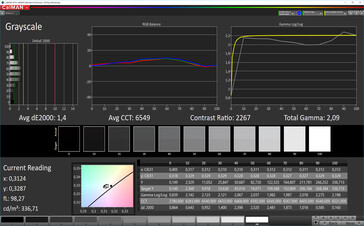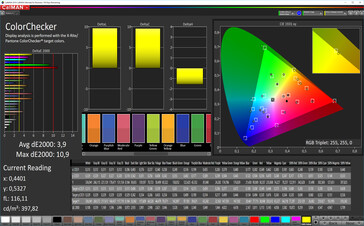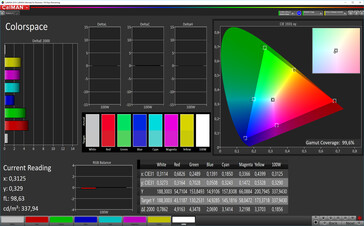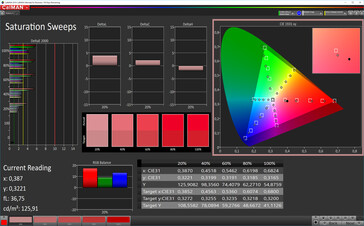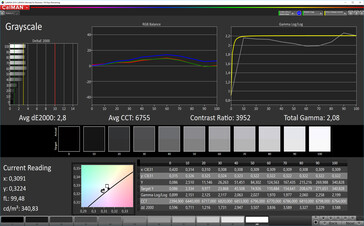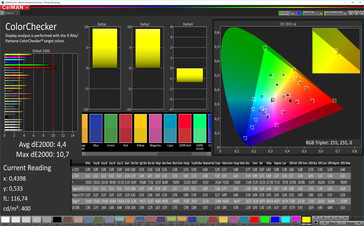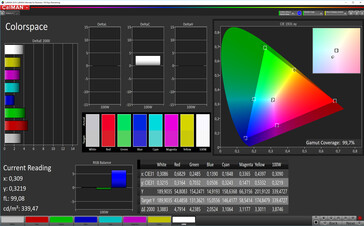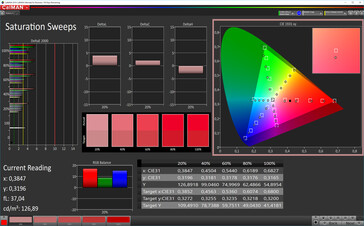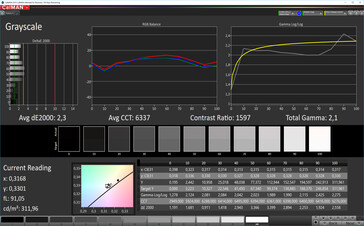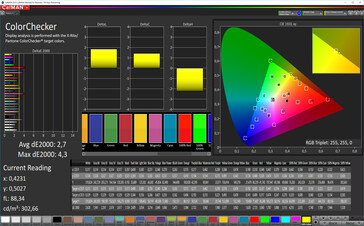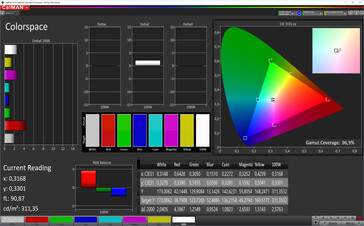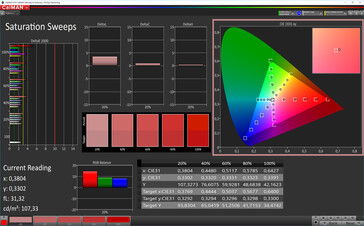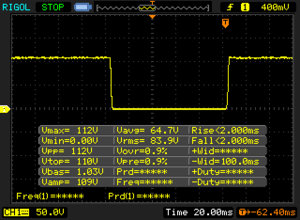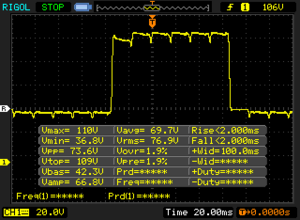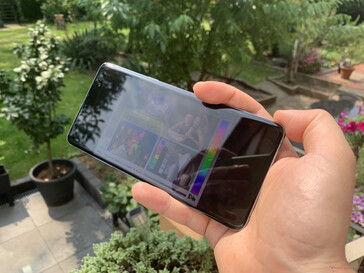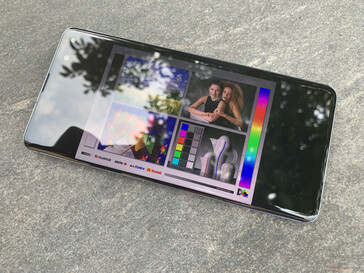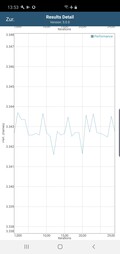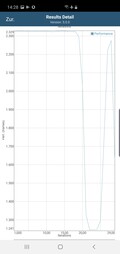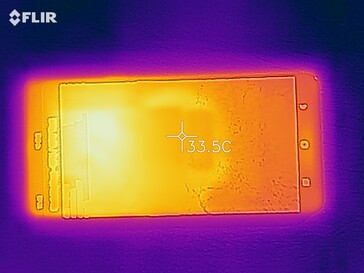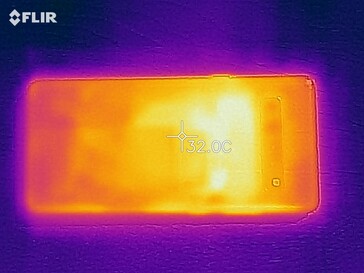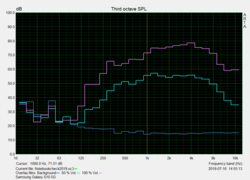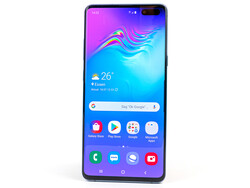Samsung Galaxy S10 5G Smartphone Review: A turbocharged S10 with a cutting-edge addition
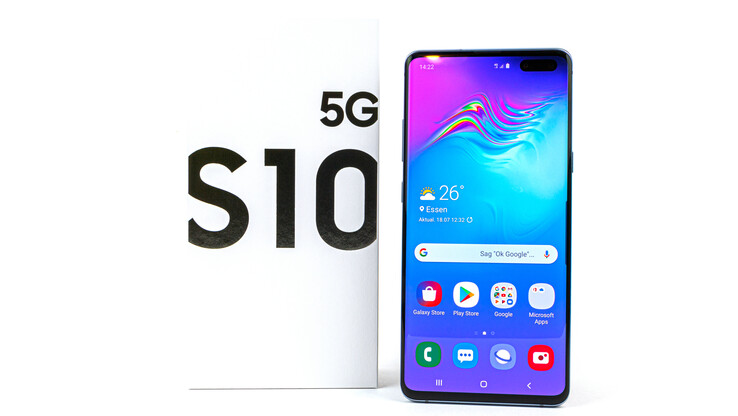
The Galaxy S10 5G (SM-G977B) completes the Galaxy S10 series and is one of the first smartphones to support 5G. The S10 5G is not just an S10+ with a 5G modem though, as it also includes a larger display and battery than its S10 siblings. Samsung has incorporated two time of flight (ToF) cameras too, which is a first for the S10 series.
Disappointingly, the S10 5G is not quite the maxed-out S10 that it could have been. The device only comes with 8 GB RAM and 256 GB of storage, with there being no higher capacity variants as there are with the Galaxy S10 and S10+. Additionally, Samsung does not currently sell an unlocked version, meaning that you must put up with carrier branding. Worse still, there is no dual-SIM version or microSD card expansion.
The 5G smartphone market remains small, with the Huawei Mate 20 X 5G, OnePlus 7 Pro 5G, Xiaomi Mi Mix 3 5G and ZTE Axon 10 Pro 5G being the S10 5G’s main competitors. Hence, we shall also compare the S10 5G against other modern flagships like the LG G8S ThinQ and Apple iPhone XS Max.
Galaxy S10 series overview
| Galaxy S10e | Galaxy S10 | Galaxy S10+ | Galaxy S10 5G | |
|---|---|---|---|---|
| Display | 5.8-inch Full HD+ | 6.1-inch Quad HD+ | 6.4-inch Quad HD+ | 6.7-inch Quad HD+ |
| RAM | 6/8 GB | 6/8 GB | 6/8/12 GB | 8 GB |
| Storage | 128/256 GB | 128/256 GB | 128/256/1.024 GB | 256 GB |
| microSD card slot | yes | yes | yes | no |
| Front-facing camera | 10 MP (Dual-Pixel-AF, f/1.9) | 10 MP (Dual-Pixel-AF, f/1.9) | 10 MP (Dual-Pixel-AF, f/1.9) + 8 MP (f/2.2) | 10 MP (Dual-Pixel-AF, f/1.9) + ToF |
| Rear-facing camera | Dual-cameras with OIS | Triple-cameras with Dual-OIS | Triple-cameras with Dual-OIS | Quad-cameras with Dual-OIS |
| 12 MP (DP-AF, f/1.5 and f/2.4) | 12 MP (DP-AF, f/1.5 and f/2.4) | 12 MP (DP-AF, f/1.5 and f/2.4) | 12 MP (DP-AF, f/1.5 and f/2.4) | |
| 16 MP (ultra-wide-angle, f/2.2) | 16 MP (ultra-wide-angle, f/2.2) | 16 MP (ultra-wide-angle, f/2.2) | 16 MP (ultra-wide-angle, f/2.2) | |
| 12 MP (telephoto, PDAF, f/2.4) | 12 MP (telephoto, PDAF, f/2.4) | 12 MP (telephoto, PDAF, f/2.4) | ||
| ToF-camera | ||||
| Ultrasonic fingerprint sensor | no | yes | yes | yes |
| 3D facial recognition | no | no | no | yes |
| Battery capacity | 3,100 mAh | 3,400 mAh | 4,100 mAh | 4,500 mAh |
| Wi-Fi battery runtime | 6 h 56 min | 7 h 7 min | 8 h 3 min | 8 h 53 min |
| 5G modem | no | no | no | yes |
| MSRP | US$749.99 | US$899.99 | US$999.99 | US$1,299.99 |
Case
The Galaxy S10 5G comes coated in Corning Gorilla Glass 6 and is as heavy as the ceramic version of the S10+. Samsung sells the S10 5G in Majestic Black and Crown Silver, although it does not offer both colours in all markets.
The S10 5G is slightly slimmer than its siblings, with our review unit measuring just 8.05 mm. Its rear-facing cameras protrude by just 0.55 mm, so the device should not rock about on a table too much. The S10 5G feels big in the hand but without being too heavy for its size.
Our review unit is well-built, and its back glass is pretty to look at, but it quickly picks up fingerprints. All gaps between materials are even and narrow with transitions also being clean. We could not twist or deform the device despite our best efforts to do so. Unfortunately, the plastic SIM card slot does not quite match the colour of the rest of the device. This is a minor gripe though. The S10 5G is also IP68-certified against dust and water just like the rest of the S10 series.
Connectivity
The S10 5G is just as well equipped as the Galaxy S10 and S10+ are. Samsung has equipped it with a USB 3.1 Type-C port that supports data transfer, audio and wired video output via HDMI or DisplayPort. The S10 5G is DeX compatible too, while you can connect external peripherals like a mouse and keyboard via Bluetooth or Type-C. Samsung also sells a DeX docking station should you prefer to keep cable clutter to a minimum.
Expectedly, the S10 5G supports all modern communication standards including Bluetooth 5.0, NFC, MST and Ant+. Samsung has included a heart-rate sensor too, which it continues to place next to the rear-facing cameras.
In short, the S10 5G is a well-equipped smartphone. However, it lacks an IR blaster, radio receiver, microSD card slot and dual-SIM functionality. While the first two are no longer in vogue, plenty of modern flagships support microSD cards and dual-SIM cards.
Software
The S10 5G ships with One UI 1.1, Samsung’s customised version of Android 9.0 Pie. Please see our Galaxy S10 and S10+ reviews where we cover One UI in greater detail. Samsung typically updates security patches every two months, with our review unit having been recently updated during our tests. You can expect at least two major OS updates too.
Unfortunately, Samsung continues to install plenty of bloatware, including several Microsoft and Facebook apps. Our review unit has Spotify and Netflix preinstalled too, along with two Vodafone apps. While their inclusion is inconvenient, we would not think too much of it if we could uninstall them. Samsung prevents us from doing so, with it only being possible to disable them. Hence, it feels like Samsung is foisting services on people, which is incomprehensible when the company is charging almost US$1,300 for the S10 5G.
Samsung also disables user account control, the inclusion of which would have made sense considering the extent to which the company pushes its DeX desktop mode. One UI includes a Kids Home app though, should you also plan to let your children use your device.
Communication & GPS
An Exynos 5100 modem is at the heart of the S10 5G, which is one of its main selling points. Unfortunately, we could not test its 5G functionality, so we cannot verify the claims made by the WSJ that the device switches to 4G in hot weather.
However, Samsung has included a slower LTE modem than the ones in the other S10 devices that we have reviewed, with it only utilising the slower LTE Cat. 19. The S10 5G supports a plethora of 2G, 3G and LTE frequencies though, so you should have no issues connecting to networks on intercontinental trips. Oddly, Samsung is somewhat stingy with 5G bands, with the S10 5G only supporting NR78. China, the US and most of Europe use NR78, but you may find yourself caught out in countries like Japan. The S10 5G falls short of its contemporaries too, with the Axon 10 Pro 5G and Mate 20 X 5G supporting more 5G bands than it does. Specifically, the Axon 10 Pro 5G utilises NR41 and NR78 while the Mate 20 X 5G supports NR77, NR78 and NR79. Theoretically, the S10 5G can achieve up to 2.33 Gb/s download speeds and 469 Mb/s upload speeds.
The S10 5G supports Wi-Fi 6, although we were unable to test the device’s maximum transfer speeds as our Linksys EA 8500 reference router does not comply with the new standard. However, our review unit could not maintain stable Wi-Fi performance for some reason, with it dropping below 400 Mb/s in both iperf3 Client Wi-Fi tests that we conducted. Most Wi-Fi networks do not operate at these speeds though, so this should not be an issue in daily use. Our review unit has decent Wi-Fi range, although we noticed that it took longer to switch to a stronger Wi-Fi network than most other modern smartphones do.
The S10 uses 5G GPS, Glonass, BeiDou and Galileo for location services. The device does not support dual-band GPS as some devices do, but it still achieves a satfix with up to four metres accuracy outdoors. The device takes a bit longer to locate us indoors and can only do so with up to 16 metres accuracy.
We also took our review unit on a short bike ride to compare its location accuracy against our trusty Garmin Edge 500. The latter proved more accurate during our test, but the S10 5G was not far behind and is good enough for general navigation tasks like cycling, driving or walking.
Telephone Features and Call Quality
Cameras
Samsung has equipped the S10 5G with the same 10 MP front-facing camera that it has included in its other S10 devices. However, it has included a ToF camera as a secondary sensor rather than the 8 MP camera that it used in the S10+. The ToF camera can collect depth information faster and more accurately than a traditional camera could, which allows it to be used for 3D facial authentication. The S10 5G can also record videos in up to UHD, with Samsung including AR emojis and AR stickers too. Selfies look just as good as they do on the other S10 devices that we have reviewed.
The S10 5G has the same rear-facing cameras as the S10+ too, but Samsung has added a ToF camera, giving the device six cameras. The S10 5G uses the ToF sensor for optimising portrait shots and for measuring objects, an example of which we have included to the right of this section. We found the process of measuring something cumbersome, and you can only measure something up to 167 cm away. However, our review unit consistently measured things accurately.
Accessories & Warranty
The S10 5G comes with a Type-C cable, a 25 W charger, a SIM tool, an OTG adapter, a set of AKG-branded headphones, along with some warranty, safety and quick-start literature. Samsung does not currently sell any S10 5G-specific accessories, but it does plan to do so.
The S10 5G comes with 24 months manufacturer’s warranty, 12 months for the battery and six months for the accessories that are included in the box. Samsung also offers its Care+ additional warranty package, which currently costs 149 Euros (~US$166) and which covers your smartphone from accidental damage including, but not limited to, breaking the screen and liquid damage. Samsung limits the additional coverage to two claims within the service period, each of which is subject to a 59-Euro (~US$66) excess fee.
Please see our Guarantees, Return Policies & Warranties FAQ for more country-specific information.
Input Devices & Operation
The capacitive touchscreen detects up to 10 touches simultaneously, with the one in our review unit converting them quickly and reliably across all areas of the display. The protective glass layer is pleasantly smooth too and is less prone to picking up smudges than the back glass. Parenthetically, the three hardware buttons have clear pressure points, short strokes and sit firmly in their apertures.
The S10 5G can be unlocked either by using a password, pattern, PIN, the in-screen ultrasonic fingerprint scanner or 3D facial authentication, the latter of which is new to the S10 series. All methods worked well during our tests, while the 3D facial authentication is about as accurate and fast as the systems in the Huawei Mate 20 Pro and iPhone XS. The G8S ThinQ does a better job though, as its Infineon ToF camera is not only noticeably faster but also takes up less space than the ToF camera that Samsung has used in the S10 5G.
The on-screen keyboard, Bixby and one-handed operation all function as they do on the S10+. However, we found the latter harder to use during our tests because of the S10 5G’s larger display.
Display
The S10 5G has a 6.7-inch (17.02 cm, 112 cm²) display, making it 0.3-inch larger than the ones in the S10+ and Note 9. The Dynamic AMOLED panel operates natively at 3040x1440 (WQHD+), but Samsung sets it to 2280x1080 (Full HD+) by default. The screen looks pin-sharp in resolutions, but it will deliver a more visually impressive experience at 1440p than it will at 1080p.
The screen in our review unit is on par with the one in the S10+ that we reviewed, with it achieving an average maximum luminosity of 735 cd/m² according to X-Rite i1Pro 2. Some areas exceed 750 cd/m² too, which yields a 94% even brightness distribution. However, you must keep automatic brightness on to experience such high luminosity, as switching to manual brightness results in maximum luminosity dropping to just 345 cd/m². Our review unit manages 1,000 cd/m² in the more practical APL50 test too and an astonishing 1,107 cd/m² in APL10, meaning that you should have no issues with reading the display even under the brightest of lights. The display gets bright enough to utilise HDR10+ as well.
The S10 5G also has an excellent contrast ratio, as its AMOLED panel can switch off pixels individually. In short, this means that blacks look true to life as they are represented by switched-off pixels.
The display gets impressively dim too, with X-Rite i1Pro 2 recording a minimum luminosity of just 1.62 cd/m². Samsung includes a blue-light filter and an integrated night mode, which should make eBooks or websites easy to read at night. Unfortunately, the panel uses pulse-width modulation (PWM) to regulate screen brightness, with our panel flickering between 60 and 240.4 Hz. These frequencies are low enough to cause health issues like eye strain and headaches for those who are PWM sensitive, so it would be good if Samsung included DC dimming like OnePlus and Xiaomi, as this near eliminates any display flickering.
The S10 5G has an always-on-display (AoD) like its S10 siblings. Samsung offers plenty of AoD configuration options within One UI too.
| |||||||||||||||||||||||||
Brightness Distribution: 94 %
Center on Battery: 735 cd/m²
Contrast: ∞:1 (Black: 0 cd/m²)
ΔE ColorChecker Calman: 3.9 | ∀{0.5-29.43 Ø4.83}
ΔE Greyscale Calman: 1.4 | ∀{0.09-98 Ø5.1}
96.9% sRGB (Calman 2D)
Gamma: 2.09
CCT: 6549 K
| Samsung Galaxy S10 5G OLED, 3040x1440, 6.7" | Samsung Galaxy S10 Plus OLED, 3040x1440, 6.4" | Huawei Mate 20 X OLED, 2244x1080, 7.2" | ZTE Axon 10 Pro AMOLED, 2340x1080, 6.5" | OnePlus 7 Pro AMOLED, 3120x1440, 6.7" | Apple iPhone Xs Max OLED, 2688x1242, 6.5" | LG G8s ThinQ P-OLED, 2248x1080, 6.2" | |
|---|---|---|---|---|---|---|---|
| Screen | 0% | 11% | -37% | 15% | 14% | -13% | |
| Brightness middle | 735 | 710 -3% | 421 -43% | 402 -45% | 586 -20% | 656 -11% | 539 -27% |
| Brightness | 735 | 721 -2% | 418 -43% | 399 -46% | 584 -21% | 659 -10% | 556 -24% |
| Brightness Distribution | 94 | 97 3% | 96 2% | 92 -2% | 97 3% | 88 -6% | 88 -6% |
| Black Level * | |||||||
| Colorchecker dE 2000 * | 3.9 | 3.7 5% | 1.1 72% | 4.1 -5% | 1.39 64% | 1.7 56% | 3.78 3% |
| Colorchecker dE 2000 max. * | 10.9 | 10.3 6% | 2.2 80% | 6.5 40% | 2.7 75% | 2.8 74% | 6.95 36% |
| Greyscale dE 2000 * | 1.4 | 1.5 -7% | 1.4 -0% | 3.7 -164% | 1.6 -14% | 1.7 -21% | 2.2 -57% |
| Gamma | 2.09 105% | 2.1 105% | 2.23 99% | 2.23 99% | 2.243 98% | 1.998 110% | 2.274 97% |
| CCT | 6549 99% | 6611 98% | 6723 97% | 7841 83% | 6672 97% | 6487 100% | 6013 108% |
* ... smaller is better
Screen Flickering / PWM (Pulse-Width Modulation)
| Screen flickering / PWM detected | 240.4 Hz | ≤ 99 % brightness setting | |
The display backlight flickers at 240.4 Hz (worst case, e.g., utilizing PWM) Flickering detected at a brightness setting of 99 % and below. There should be no flickering or PWM above this brightness setting. The frequency of 240.4 Hz is relatively low, so sensitive users will likely notice flickering and experience eyestrain at the stated brightness setting and below. In comparison: 53 % of all tested devices do not use PWM to dim the display. If PWM was detected, an average of 8327 (minimum: 5 - maximum: 343500) Hz was measured. | |||
We checked the colour accuracy of our review unit’s display using a photo spectrometer and CalMAN software. We should point out that Samsung has reduced the number of screen customisation options in One UI compared to the ones that it included in Samsung Experience. The company differentiates between display modes by “Vivid” and “Natural”, of which it sets the latter as the default with the S10 5G.
Samsung bases the “Natural” mode on sRGB and has a warmer white balance than the “Vivid” mode, which is based on the wider DCI-P3 colour space. The former is more colour accurate than the latter though.
Fortunately, you can tweak the settings to compensate for the poorly calibrated white balance. It is worth noting that Samsung only allows this to be done in the “Vivid” mode, for some reason. We have included our re-calibrated display settings in the screenshot above, which reduces Delta-E deviations. Colours still do not look as accurate as they do with the display set to “Natural”, especially reds, but at least you do not need to forgo the wider colour space that the “Vivid” mode offers.
In general, the S10 5G has decent colour accuracy and is on par with the S10+. Neither is great, though.
Display Response Times
| ↔ Response Time Black to White | ||
|---|---|---|
| 4 ms ... rise ↗ and fall ↘ combined | ↗ 2 ms rise | |
| ↘ 2 ms fall | ||
| The screen shows very fast response rates in our tests and should be very well suited for fast-paced gaming. In comparison, all tested devices range from 0.1 (minimum) to 240 (maximum) ms. » 14 % of all devices are better. This means that the measured response time is better than the average of all tested devices (20.5 ms). | ||
| ↔ Response Time 50% Grey to 80% Grey | ||
| 4 ms ... rise ↗ and fall ↘ combined | ↗ 2 ms rise | |
| ↘ 2 ms fall | ||
| The screen shows very fast response rates in our tests and should be very well suited for fast-paced gaming. In comparison, all tested devices range from 0.165 (minimum) to 636 (maximum) ms. » 13 % of all devices are better. This means that the measured response time is better than the average of all tested devices (32.1 ms). | ||
The S10 5G is easy to use outdoors thanks to its bright AMOLED panel. Some reflections reduce readability, but we only noticed this when looking at the display from side-on. The ambient light sensor also worked quickly during our tests and adjusted the display’s luminosity smoothly. In short, you should have no issues with reading the display outdoors, even on a sunny day.
Performance
Samsung equips the S10 5G with an Exynos 9820 like its S10 siblings, which integrates an ARM Mali-G76 MP12 GPU among other components. However, the device comes with only 8 GB of LPDDR4x RAM; by contrast, all other S10 models have at least a 6 GB option. The S10+ even has a 12 GB variant too.
As expected, the S10 5G performs just as well in synthetic benchmarks at 1440p as the Galaxy S10 and the S10+. The S10e occasionally outscores its more expensive S10 siblings in some GPU benchmarks though, as its Mali-G76 MP12 only has to render in up to 1080p rather than 1440p.
The Exynos 9820 performs particularly well in single-core benchmarks where it only finishes second to the Apple A12 Bionic. However, the Snapdragon 855 proves faster in multicore benchmarks. The Adreno 640 often falls short of the Mali-G76 MP12 in GPU tests though as our comparison tables below demonstrate.
The Exynos 9820 delivers solid performance in daily use too. Our review unit ran smoothly during our tests and even when we subjected it to heavy multitasking in DeX, so we have no complaints here.
| Basemark GPU 1.1 | |
| 1920x1080 Vulkan Medium Offscreen (sort by value) | |
| OnePlus 7 Pro | |
| Samsung Galaxy S10 Plus | |
| Average Samsung Exynos 9820 (38.4 - 38.6, n=3) | |
| Vulkan Medium Native (sort by value) | |
| OnePlus 7 Pro | |
| Samsung Galaxy S10 Plus | |
| Average Samsung Exynos 9820 (27.2 - 36.2, n=3) | |
| 1920x1080 OpenGL Medium Offscreen (sort by value) | |
| OnePlus 7 Pro | |
| Samsung Galaxy S10 Plus | |
| Average Samsung Exynos 9820 (32.3 - 33, n=3) | |
| VRMark - Amber Room (sort by value) | |
| OnePlus 7 Pro | |
| Samsung Galaxy S10 Plus | |
| Average Samsung Exynos 9820 (n=1) | |
| Average of class Smartphone (n=1last 2 years) | |
| Basemark ES 3.1 / Metal - offscreen Overall Score (sort by value) | |
| ZTE Axon 10 Pro | |
| OnePlus 7 Pro | |
| Apple iPhone Xs Max | |
| Samsung Galaxy S10 Plus | |
| Average Samsung Exynos 9820 (1927 - 1937, n=3) | |
| Average of class Smartphone (205 - 7616, n=46, last 2 years) | |
We used the preinstalled Samsung browser for our browser benchmarks, which could misrepresent our results slightly. However, the S10 5G performed in line with its S10 counterparts and felt smooth when web browsing in daily use. Overall, you should experience no issues when using the default browser.
| Jetstream 2 - 2.0 Total Score | |
| Average of class Smartphone (13.8 - 387, n=154, last 2 years) | |
| OnePlus 7 Pro (Chrome 74) | |
| LG G8s ThinQ (Chrome 75) | |
| ZTE Axon 10 Pro (Chrome 74) | |
| Samsung Galaxy S10 5G (Samung Browser 9.2) | |
| Average Samsung Exynos 9820 (44.1 - 44.4, n=2) | |
| Samsung Galaxy S10 Plus (Samung Browser 9.0) | |
| Speedometer 2.0 - Result | |
| Average of class Smartphone (15.2 - 585, n=137, last 2 years) | |
| ZTE Axon 10 Pro (Chrome 74) | |
| LG G8s ThinQ (Chome 75) | |
| OnePlus 7 Pro (Chome 74) | |
| Samsung Galaxy S10 5G (Samsung Browser 9.2) | |
| Samsung Galaxy S10 Plus (Samsung Browser 9.0) | |
| Average Samsung Exynos 9820 (54 - 57, n=3) | |
| WebXPRT 3 - Overall | |
| Average of class Smartphone (38 - 347, n=55, last 2 years) | |
| Apple iPhone Xs Max (Safari 12) | |
| Samsung Galaxy S10 Plus (Samsung Browser 9.0) | |
| Samsung Galaxy S10 5G | |
| Average Samsung Exynos 9820 (115 - 115, n=2) | |
| OnePlus 7 Pro (Chrome 74) | |
| LG G8s ThinQ (Chrome 75) | |
| ZTE Axon 10 Pro (Chrome 74) | |
| Huawei Mate 20 X (hrome 71) | |
| Octane V2 - Total Score | |
| Average of class Smartphone (2228 - 100368, n=204, last 2 years) | |
| Apple iPhone Xs Max (Safari 12) | |
| ZTE Axon 10 Pro (Chrome 74) | |
| OnePlus 7 Pro (Chrome 74) | |
| LG G8s ThinQ (Chrome 75) | |
| Huawei Mate 20 X (hrome 71) | |
| Samsung Galaxy S10 Plus (Samsung Browser 9.0) | |
| Samsung Galaxy S10 5G (Samsung Browser 9.2) | |
| Average Samsung Exynos 9820 (18697 - 20849, n=4) | |
| Mozilla Kraken 1.1 - Total | |
| Huawei Mate 20 X (hrome 71) | |
| LG G8s ThinQ (Chrome 75) | |
| OnePlus 7 Pro (Chrome 74) | |
| Average Samsung Exynos 9820 (1823 - 2240, n=4) | |
| Samsung Galaxy S10 Plus (Samsung Browser 9.0) | |
| ZTE Axon 10 Pro (Chrome 74) | |
| Samsung Galaxy S10 5G (Samsung Browser 9.2) | |
| Average of class Smartphone (277 - 28190, n=158, last 2 years) | |
| Apple iPhone Xs Max (Safari 12) | |
| JetStream 1.1 - Total Score | |
| Apple iPhone Xs Max (Safari 12) | |
| ZTE Axon 10 Pro (Chrome 74) | |
| LG G8s ThinQ (Chrome 75) | |
| Huawei Mate 20 X (hrome 71) | |
| Samsung Galaxy S10 Plus (Samsung Browser 9.0) | |
| Samsung Galaxy S10 5G (Samsung Browser 9.2) | |
| Average Samsung Exynos 9820 (84 - 91.8, n=3) | |
* ... smaller is better
Samsung has equipped the S10 5G with UFS 2.1 flash storage, which performed well in AndroBench. However, it cannot keep up with the faster UFS 3.0 standard, as demonstrated by the gap to the OnePlus 7 Pro. The Axon 10 Pro and Mate 20 X have considerably better random 4 KB write speeds too, which distorts our results somewhat.
The S10 5G only comes with 256 GB of storage, of which around 226 GB is free upon first booting the device. While this will probably be enough for most people, we cannot understand why Samsung chose to omit a microSD card reader. All other S10 devices have one, making the failure to include one in the most expensive variant even odder.
| Samsung Galaxy S10 5G | Huawei Mate 20 X | ZTE Axon 10 Pro | OnePlus 7 Pro | LG G8s ThinQ | Samsung Galaxy S10 Plus | Average 256 GB UFS 2.1 Flash | Average of class Smartphone | |
|---|---|---|---|---|---|---|---|---|
| AndroBench 3-5 | 223% | 202% | 43% | -1% | -1% | 146% | 551% | |
| Sequential Read 256KB | 816 | 912 12% | 769 -6% | 1468 80% | 791 -3% | 811 -1% | 829 ? 2% | 2158 ? 164% |
| Sequential Write 256KB | 246.3 | 182.7 -26% | 503 104% | 387 57% | 182.4 -26% | 249.1 1% | 376 ? 53% | 1749 ? 610% |
| Random Read 4KB | 135 | 144.4 7% | 150.4 11% | 174.1 29% | 138 2% | 135.2 0% | 168.8 ? 25% | 294 ? 118% |
| Random Write 4KB | 23.79 | 237.6 899% | 189.5 697% | 24.8 4% | 29.6 24% | 22.7 -5% | 143.6 ? 504% | 336 ? 1312% |
Games
The S10 5G should be a great gaming smartphone, at least on paper. We expected its powerful SoC, huge display and stereo speakers to deliver an immersive gaming experience, but the S10 5G cannot live up to expectations, as our GameBench frame-rate graphs below demonstrate.
In short, our review unit cannot maintain peak frame rates, with it fluctuating between 48 and 60 FPS in Arena of Valor. Likewise, PUBG Mobile runs at between 28 and 41 FPS, so we would recommend dropping the graphics settings for a smoother gaming experience. We would have expected better from a US$1,300 smartphone here.
The touchscreen and associated sensors worked perfectly during our tests, but the speakers often sounded tinny, as we will explain in the Speakers section of this review. The front-facing cameras do not interfere with any in-game UIs though, as it is hidden by a black bar.
PUBG Mobile & Arena of Valor
Emissions
Temperature
The S10 5G manages its surface temperatures well at idle, with our review unit averaging 22.5 °C during our tests. The same applies under sustained load too, with surface temperatures peaking at 35.2 °C on the front of the device and averaging a pleasantly cool 31 °C across the whole device. In short, the S10 5G should never feel hot to the touch even if you are pushing it to its limits.
We also subjected our review unit to several GFXBench battery tests to determine how it manages its performance under sustained load. We ran the T-Rex and Manhattan benchmarks 30 times on a loop and recorded any changes in frame rates or battery life for each benchmark run-through. Modern smartphones often breeze through T-Rex but struggle in Manhattan, which is the case with the S10 5G. Our review unit maintained consistent frame rates during the former but throttled heavily in the latter after around the 18th loop. Overall, you should not notice drops in frame rates during short gaming sessions, but you may do so in prolonged ones.
(+) The maximum temperature on the upper side is 35.2 °C / 95 F, compared to the average of 35.1 °C / 95 F, ranging from 21.9 to 63.7 °C for the class Smartphone.
(+) The bottom heats up to a maximum of 31.8 °C / 89 F, compared to the average of 33.9 °C / 93 F
(+) In idle usage, the average temperature for the upper side is 23 °C / 73 F, compared to the device average of 32.9 °C / 91 F.
Speakers
The Galaxy S10 5G has stereo speakers like its S10 siblings, with it using its earpiece as a secondary speaker. The speakers get loud, with them reaching a maximum of 86.7 dB(A) during our tests, and their frequency response is decent, but they sound tinny in everyday life. We can hardly hear any deep mid or bass tones, so there is nothing to offset high-pitched frequencies. Worse still, the speakers distort at maximum volume, which is unfortunate.
Thankfully, audio outputted by the 3.5 mm jack sounds much better than it does with the stereo speakers, with the former reproducing audio cleanly and without any electrical interference. The S10 5G supports audio-out via Type-C and Bluetooth, with the latter able to operate at up to the 5.0 standard. While the device supports modern codecs like SBC, AAC, aptX and LDAC, Samsung continues to omit aptX HD, which is a shame. The S10 5G supports dual-audio Bluetooth too, meaning that it can stream audio to two sets of external audio equipment simultaneously.
Samsung Galaxy S10 5G audio analysis
(+) | speakers can play relatively loud (86.7 dB)
Bass 100 - 315 Hz
(-) | nearly no bass - on average 20.5% lower than median
(±) | linearity of bass is average (13.5% delta to prev. frequency)
Mids 400 - 2000 Hz
(+) | balanced mids - only 4.6% away from median
(+) | mids are linear (4% delta to prev. frequency)
Highs 2 - 16 kHz
(±) | higher highs - on average 7.9% higher than median
(+) | highs are linear (5% delta to prev. frequency)
Overall 100 - 16.000 Hz
(±) | linearity of overall sound is average (19.3% difference to median)
Compared to same class
» 24% of all tested devices in this class were better, 9% similar, 67% worse
» The best had a delta of 12%, average was 36%, worst was 134%
Compared to all devices tested
» 45% of all tested devices were better, 8% similar, 48% worse
» The best had a delta of 4%, average was 24%, worst was 134%
Huawei Mate 20 X audio analysis
(+) | speakers can play relatively loud (84.1 dB)
Bass 100 - 315 Hz
(-) | nearly no bass - on average 17.3% lower than median
(±) | linearity of bass is average (13.8% delta to prev. frequency)
Mids 400 - 2000 Hz
(±) | higher mids - on average 5.7% higher than median
(+) | mids are linear (4.6% delta to prev. frequency)
Highs 2 - 16 kHz
(±) | higher highs - on average 7.1% higher than median
(+) | highs are linear (5.8% delta to prev. frequency)
Overall 100 - 16.000 Hz
(±) | linearity of overall sound is average (20.2% difference to median)
Compared to same class
» 31% of all tested devices in this class were better, 9% similar, 60% worse
» The best had a delta of 12%, average was 36%, worst was 134%
Compared to all devices tested
» 51% of all tested devices were better, 8% similar, 41% worse
» The best had a delta of 4%, average was 24%, worst was 134%
Power Management
Power Consumption
The S10 5G has a comparatively average power consumption, although it rises exponentially when we manually set the display to full brightness. Our review unit still consumes up to 0.08 W on standby, but this is not particularly onerous.
Samsung includes a 25 W power supply in the box that recharges the device’s 4,500 mAh battery quickly. The S10 5G needed just 86 minutes for a full charge during our tests and reached 50% charge after just 26 minutes. It took around 49 minutes to hit 80% and an additional 15 minutes to hit 90%.
Alternatively, you can charge the S10 5G with any Qi-standard wireless charger. Moreover, you could use Wireless PowerShare to charge other devices that support the Qi standard.
| Off / Standby | |
| Idle | |
| Load |
|
Key:
min: | |
| Samsung Galaxy S10 5G 4500 mAh | Huawei Mate 20 X 5000 mAh | ZTE Axon 10 Pro 4000 mAh | OnePlus 7 Pro 4000 mAh | Apple iPhone Xs Max 3174 mAh | LG G8s ThinQ 3550 mAh | Samsung Galaxy S10 Plus 4100 mAh | Average Samsung Exynos 9820 | Average of class Smartphone | |
|---|---|---|---|---|---|---|---|---|---|
| Power Consumption | -1% | 23% | -13% | 7% | -13% | -0% | 8% | -5% | |
| Idle Minimum * | 0.66 | 0.79 -20% | 0.76 -15% | 0.9 -36% | 1 -52% | 1.2 -82% | 0.73 -11% | 0.65 ? 2% | 0.868 ? -32% |
| Idle Average * | 1.82 | 1.72 5% | 1.15 37% | 1.8 1% | 1.4 23% | 1.6 12% | 1.53 16% | 1.455 ? 20% | 1.426 ? 22% |
| Idle Maximum * | 1.83 | 1.83 -0% | 1.18 36% | 2.9 -58% | 1.7 7% | 2 -9% | 2.07 -13% | 1.675 ? 8% | 1.588 ? 13% |
| Load Average * | 6.11 | 5.53 9% | 3.95 35% | 5.5 10% | 4.6 25% | 5 18% | 6.03 1% | 5.88 ? 4% | 7.17 ? -17% |
| Load Maximum * | 9.81 | 9.85 -0% | 7.49 24% | 8.2 16% | 6.7 32% | 10 -2% | 9.18 6% | 9.44 ? 4% | 10.8 ? -10% |
* ... smaller is better
Battery Life
The S10 5G has a 4,500 mAh battery, which is larger than all but the Mate 20 X of our comparison devices. However, our review unit eats through its battery, with it only lasting 8:53 hours in our practical Wi-Fi battery life test.
We suspect that the culprits here are the 5G and Wi-Fi modems, the latter of which was also a thorn in the side of our other Galaxy S10 review units. The S10 5G still averages about 24% longer runtimes than the S10+, but it falls between 28% and 47% short of our comparison devices, despite most of them having small batteries.
| Samsung Galaxy S10 5G 4500 mAh | Samsung Galaxy S10 Plus 4100 mAh | Huawei Mate 20 X 5000 mAh | Apple iPhone Xs Max 3174 mAh | LG G8s ThinQ 3550 mAh | ZTE Axon 10 Pro 4000 mAh | OnePlus 7 Pro 4000 mAh | |
|---|---|---|---|---|---|---|---|
| Battery Runtime | -24% | 5% | -15% | -16% | -6% | -8% | |
| Reader / Idle | 2340 | 1560 -33% | 1984 -15% | 1305 -44% | 1689 -28% | 1927 -18% | 1745 -25% |
| H.264 | 1047 | 921 -12% | 986 -6% | 801 -23% | 753 -28% | 1068 2% | 802 -23% |
| WiFi v1.3 | 533 | 483 -9% | 786 47% | 742 39% | 693 30% | 680 28% | 768 44% |
| Load | 327 | 187 -43% | 300 -8% | 223 -32% | 203 -38% | 217 -34% | 236 -28% |
Pros
Cons
Verdict
The Galaxy S10 5G distinguishes itself from its peers in more ways than just its 5G modem. However, the latter overshadows many components that would be positives in other smartphones. Take the 4,500 mAh battery, for instance, which is larger than all but the battery in the Mate 20 X of the S10 5G’s contemporaries. 4,500 mAh is an impressively large battery on paper, but the 5G modem eats through it, giving our review unit less than 10 hours of Wi-Fi usage between charges. Moreover, Samsung currently only sells the S10 5G with carrier branding, of which we are not fans.
Also, Samsung still refuses to include support for aptX HD, and while the Exynos 9820 is a powerful SoC, the ARM Mali-G76 MP12 GPU stutters when playing challenging games. We appreciate that this a minor gripe, but we expect more from a US$1,300 smartphone. The omission of a microSD card slot is difficult to swallow too, especially considering that Samsung included one in all other S10 series smartphones. Incidentally, the speakers will not win any awards either.
The Samsung Galaxy S10 5G is a strong premiere for the new mobile standard, but a few niggles prevent it from blowing us away.
Conversely, the S10 5G has practically all the features that you could wish for from a modern flagship. Its huge AMOLED display gets extremely bright, with colours reproduced vividly and accurately. Samsung has done a great job with the cameras too, and we like the inclusion of ToF sensors as well. The ultrasonic fingerprint sensor works just as well as it does on the S10 and S10+, and it is nice to have the option of using 3D facial authentication instead. Having a 3.5 mm headphone jack is always welcome too.
The Galaxy S10 5G is a great choice if you are in the market for a phablet even when discounting its 5G capabilities. However, it looks mighty pricy next to its S10 siblings, while its few but glaring shortcomings may have people looking elsewhere.
Samsung Galaxy S10 5G
- 09/03/2022 v7 (old)
Daniel Schmidt




